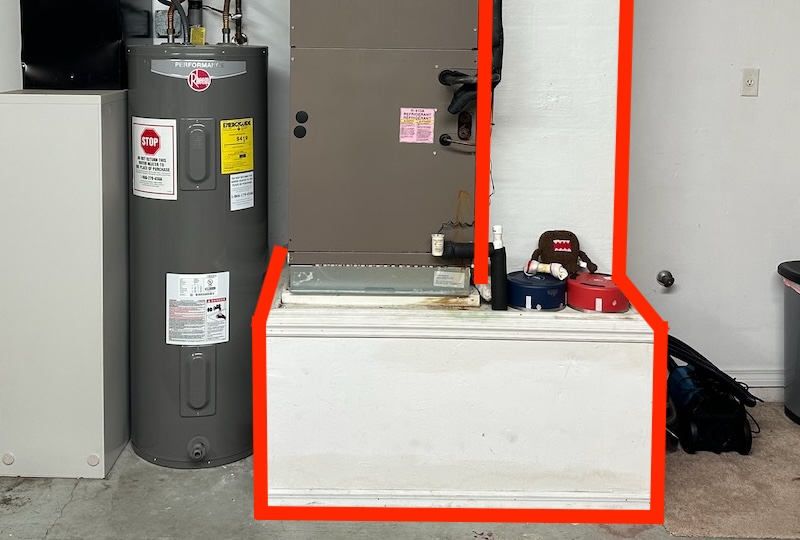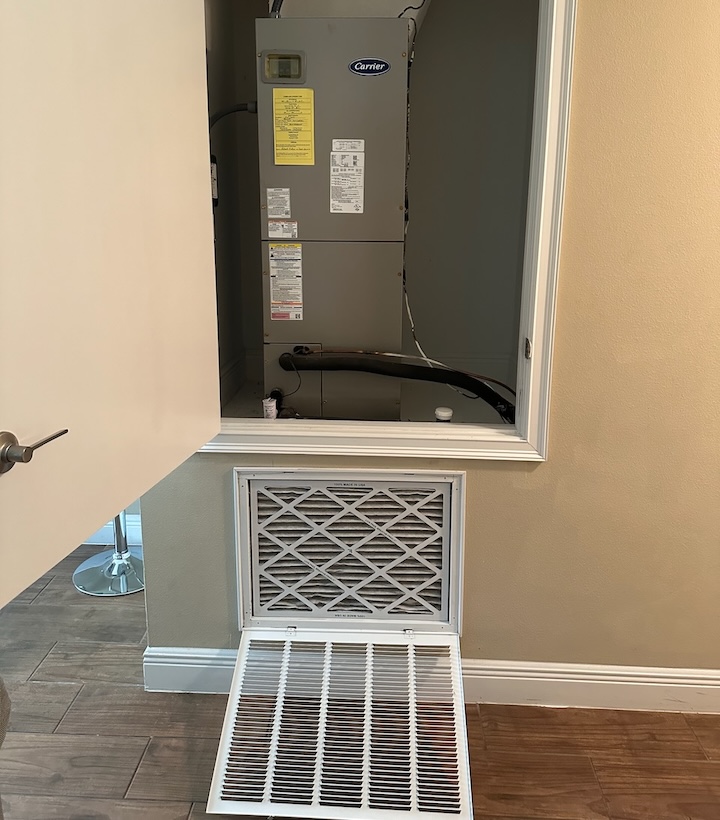Platform Return Problems in Polluted Places

Last the week I attended the HVAC/R Symposium in central Florida. Three of us from Energy Vanguard went, so we rented an Airbnb. Of course, one of the first things we did upon arrival was scope out the house, especially the heating and cooling system. It was no surprise that we found it had a platform return plenum (defined below). Nor was it surprising to find it in the garage. Florida is the land of the garage platform return, you know. The bad news is that those two things can seriously harm a home’s indoor air quality.
The video above is a brief introduction to this type of ducting and some of the problems with that particular installation. Let’s look at this issue in greater detail now.
What is a platform return?
A platform return plenum is one of the easiest HVAC concepts to understand. It’s exactly what the name says it is. But first, let’s look at this annotated photo showing how a forced air heating and cooling system moves air.
![Annotated diagram showing air flow through a heating and cooling system [Public domain image from Building America Solutions Center]](https://www.energyvanguard.com/wp-content/uploads/2025/02/furnace-AC-plenums-filter-annotated-720.jpg)
In contrast, a platform return uses site-built ducting. It’s just a big box with the air handler sitting on top. The lead photo of this article shows our Airbnb’s platform return plenum highlighted in red. In addition, the inside of the return plenum is often connected to building cavities, like the wall behind the HVAC system.
Leaks and indoor air pollutants
Here’s the thing about platform returns, though. Because they’re built on-site using non-standard duct materials, they often don’t get sealed up well. And because they’re on the return side, those site-built, potentially leaky ducts are under negative pressure. Remember, the blower is pulling air back from the house through the return side of the duct system.

So, what could go wrong? The best case scenario is that the platform return is inside the house and sealed properly to prevent pulling in dirty air. That’s kind of what we had in our Airbnb last year (photo above). The garage was on the other side of that air handler closet, though, so there may have been some connections to the bad air there.
But when you put the system in the garage on a platform return, you’re just asking for trouble. When the return ducts leak there, a lot of bad pollutants can get pulled into the system and then distributed throughout the house. That could include:
- carbon monoxide
- water vapor (not a pollutant per se, but often a problem in humid climates)
- emissions from pesticides, paint, gasoline,
- automobile exhaust
Worse, if the garage has a natural draft gas water heater, the negative pressure created by return leakage could cause it to backdraft. That simply means the exhaust gases from the combustion don’t go up the flue and out of the house. Instead, they get pulled into the garage. From there, they can get pulled into the duct system from the return leaks and then be sent into the house. A clothes dryer in the garage also can cause the water heater to backdraft.
Better ways to move air
The good news is that the kind of platform return we saw in our Airbnb last week is not allowed in new homes. Here’s what the 2021 International Residential Code (IRC) specifies for ducts in a garage:
R302.5.2 Duct penetration. Ducts in the garage and ducts penetrating the walls or ceilings separating the dwelling from the garage shall be constructed of a minimum No. 26 gauge (0.48 mm) sheet steel or other approved material and shall not have openings into the garage.
The IRC, however, is simply a model code. The code in effect in your location is set by the state or a local authority having jurisdiction. And they often do something different. That seems to be the case in Florida, because a contractor I know there told me platform returns are still being installed and approved.
As I’ve written here many times, the best place for ducts is in conditioned space. Not the attic. Not a vented crawl space. And definitely not the garage.
Even in conditioned space, though, you want to have your ducts sealed. That ensures that your air moves the way it’s supposed to move. It also helps keeps the pressures in the house balanced. Negative pressures anywhere can cause problems.
If you have a platform return plenum—especially one in the garage—you should line it with approved duct materials and make it as airtight as possible. And don’t forget the filter slot!
Allison A. Bailes III, PhD is a speaker, writer, building science consultant, and the founder of Energy Vanguard in Decatur, Georgia. He has a doctorate in physics and is the author of a bestselling book on building science. He also writes the Energy Vanguard Blog. For more updates, you can follow Allison on LinkedIn and subscribe to Energy Vanguard’s weekly newsletter and YouTube channel.
Related Articles
4 Ways a Bad Duct System Can Lead to Poor Indoor Air Quality
Want Bad Air? Put a Heating & Cooling System in Your Attached Garage
Is Negative Pressure Causing a Problem in Your Home?
Comments are welcome and moderated. Your comment will appear below after approval. To control spam, we close comments after one year.

The location of the uninsulated metal duct and arrow from the supply to return humidifier puzzles me.
My understanding is that this may be called a run-around that adds cooled-conditioned air to the return. This will recycle part of the already conditioned (cooled) 57 degree, 95-99% humid air through a humidifier.
Not a good idea during cooling cycles if the humidifier is kept wet?
Is there a high reliability means of keeping the humidifier completely dry during cooling season?
How is that managed?
A wet humidifier – Is this system not an invitation to a disaster during cooling periods?
1. I suggest that a damper added to close off the run-around during cooling seasons is only a partial solution.
2. Add R6 insulation.
3. A better solution may be to ensure that the humidifier remain completely dry during cooling periods which should allow the run around to deliver lower temperature / higher humidity air to the DX or water-cooled coils for a more favorable heat ratio during heavy loads and declining cooling performance.
But what do I know?
This is not my world. Your devotion to the science is, and appreciated.
Thanks.
dnb
Upflow units are very common here in TX in houses pre 90s. Once the 90s hit and as houses were being built again at larger numbers they started putting them in the attics…
I rarely see one in a garage and the few I have seen are generally much older houses that didn’t have AC originally. My issue with the plenums is the part no one wants to talk about and that is the noise. Regardless of how well sized the return ducting is it will be loud just because of the fact that moving air into a blower is noisy and with nothing between the blower wheel and the return vent 10″ away but a filter is not enough to dampen the noise of the fan.
I have thought about an internal wall with something to absorb some of the sound and to stop the direct line of sight for the noise to travel. It would dampen it some.
As for that filter why are we still using puny little 1-5″ filters in HVAC in homes especially in those that have room for a proper filter assm.